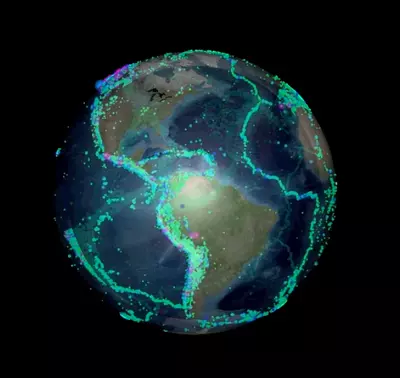Visualizing Global Earthquakes – Where and Why do Earthquakes Occur?
Summary
In this activity students visualize the distribution and magnitude of earthquakes at and below the surface of Earth and how their distribution is related to plate boundaries. Earthquakes are visualized on a 3D globe, making it easy to see their distribution within Earth's surface without having to mentally transform and interpret symbols that indicate earthquake magnitude and hypocenter depth.
Context
Audience
Introductory-level undergraduate earth science class, although talking points could be adapted for younger students by giving more background.
Skills and concepts that students must have mastered
Students should understand what earthquakes are and what causes them. Students should also understand how plates move relative to each other at the three types of plate boundaries (convergent, divergent, transform).
How the activity is situated in the course
This activity is part of a series of visualizations in a unit about plate tectonics, although each visualization could also be used in isolation.
Goals
Content/concepts goals for this activity
Students will understand the following concepts:
- The lithosphere is broken into plates of different and uneven sizes and shapes, and these plates fit together like a puzzle that covers the entire surface of Earth.
- Earthquakes are not distributed randomly, and most earthquakes occur in distinct narrow belts.
- These belts of earthquakes define the boundaries of tectonic plates because earthquakes happen in places where rocks break and move, so earthquakes occur where movement of the crust is taking place, which happens the most at plate boundaries.
- Most earthquakes are concentrated along boundaries between major tectonic plates, especially in subduction zones and along transform faults, with fewer occurring along spreading ridges.
- Earthquakes only occur on the thin veneer on the surface of the earth.
Higher order thinking skills goals for this activity
Students will be able to:
- Synthesize large data sets to recognize naturally occurring patterns
- Use patterns in data sets to make predictions about the distribution and characteristics of earthquakes
- Visualize data in 3D that is traditionally represented in 2D
Other skills goals for this activity
Description of the activity/assignment
This screenshot from this visualization shows a map of tectonic plate boundaries. The visualization transitions between global earthquake distribution to a map of plate boundaries, to clearly illustrate how they are related. This visualization also includes an overview of the distribution and magnitude of earthquakes at different types of plate boundaries. Click the image to enlarge or view the MP4 movie ( 31.1MB Jul27 11).
The purpose of this activity is to introduce students to the distribution of earthquakes at and below the surface of earth and how their distribution is related to the geometry and type of plate boundaries. Because the depth of earthquakes can be difficult for students to visualize in 2D representations, this activity allows students to visualize the 3D distribution of earthquakes within Earth's surface, which is essential for understanding how different types of earthquakes occur in different tectonic settings. Talking points and questions are included to use this visualization as part of an interactive lecture. In addition to playing back the visualization, instructors can also download the visualization software and data set and explore it themselves. Determining whether students have met the goals
'Quakes Questions' throughout each activity are short-answer questions that students answer while the visualization is playing to ensure that they are taking away key concepts. These questions require students to synthesize ideas and articulate their understanding of concepts introduced in the visualization.
More information about assessment tools and techniques.Teaching materials and tips
- Instructors Notes (Acrobat (PDF) 98kB Jul27 11): This document includes detailed description of the visualization and how it should be used in class, talking points that are linked to specific times in the visualization, and 'quakes questions' for evaluation during playback of the visualization.
Other Materials
- Visualization Video ( 31.1MB Jul27 11): Playback time 3 minutes 13 seconds. MPEG-4 movie. Includes overview of plate boundaries, earthquake distribution, and distribution at types of plate boundaries.
Supporting references/URLs
The visualization software used to create this visualization is freely available and can be downloaded from http://keckcaves.org/education/. In addition to playing back the visualizations available here, instructors can also download the visualization software and data sets and explore it themselves. Download the software and quick-start guide to begin exploring your own data sets in your classroom.
Please contact the author (clharwood@ucdavis.edu) if you would like a higher resolution video.
Please contact the author (clharwood@ucdavis.edu) if you would like a higher resolution video.




